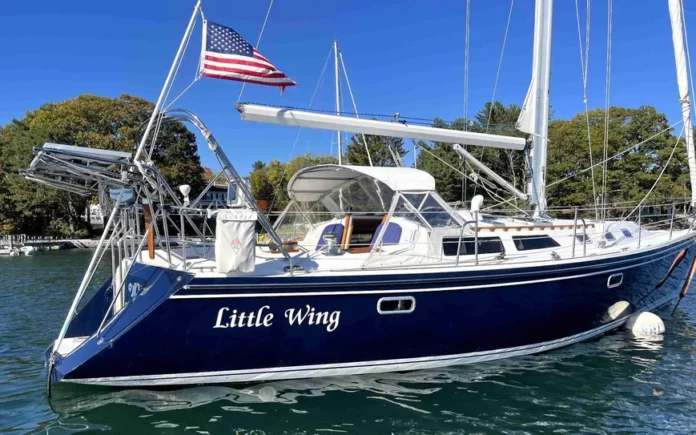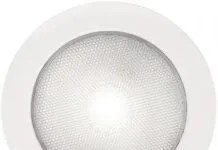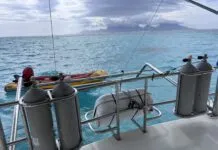
Under the guidance of Frank Butler, who founded the company in 1969, Catalina Yachts’ philosophy is to offer “as much boat for the money as possible.” The boats are relatively well made and reasonably contemporary in their designs.
Butler is able to build boats that are less expensive than similarly sized vessels by focusing on several areas: a) economy of scale; because it builds so many boats, Catalina can get a better price than smaller builders on diesel engines and just about any other equipment; b) a refusal to spend money on advertising, which can translate to a 5 percent to 10 percent savings in the cost of each boat, and c) installation of less expensive gear than is found on other boats. It’s likely, too, that the Southern California labor pool works for less than workers in, say, the Pacific Northwest or Northeast.
Catalina’s objective is to price its boats 15 percent to 20 percent below its major competitors—Hunter and Beneteau. All three are high-volume builders that move boats through the production line as quickly as possible, hence the opportunity for glitches here and there, most of which are seldom serious, but can be vexing.
THE CATALINA 42

In the words of Gerry Douglas, Catalina’s longtime chief engineer and designer who retired in 2021, “The Catalina 42 is a rather simple, sturdy boat. What you get is good quality, because the structure is there. If you want to make it more elaborate, you can take it as far as you want to go.”
Introduced in 1989, the Catalina 42 was originally envisioned as a 40-footer.
“We followed in the footsteps of the designs for the 36- and 38-footers, which were very successful, then stretched this two feet to allow room for the swim platform,” he said.
“One objective was to build a three-stateroom boat,” the first of its size introduced by an American production builder, Douglas said.
Two versions of the Catalina 42 have been built, each in a two-or three-stateroom configuration. The Mark I (hulls #1-477) was produced until February 1995, when the Mark II, which was discontinued in 2011, was introduced. More than 1,000 have been built, evenly divided between the two- and three-stateroom models.
“The design of the Mark II was influenced somewhat by the Europeans,” Douglas said, referring to the contemporary, rounded stern and modifications to the cockpit.

Just about everything else—the hull, deck, accessories, auxiliary engine and standing rigging—are virtually identical in both the MK 1 and MK 11.
Though marketing literature indicates that the Mark II, which displaces 20,500 lbs. on a 36-ft. waterline, is 2,500 lbs. heavier than its predecessor, that apparently isn’t the case.
“Our mistake,” Douglas said. “The Mark I was not that light (18,000 lbs.).”
“Two requirements,” he said, “were that the shape have lots of volume but still be slippery. She’s finer forward than her predecessors, has a straight run aft and is relatively flat at the keel. The skeg is reminiscent of that on the Catalina 34 and 36.”
Owners say that they feel the skeg improves tracking and stiffens her while pounding to weather.
The keel is trapezoidal—parallel at top and bottom. The first shoal draft boats have a wing on the 4-ft. 10-in. keel and a rather short rudder. Later models have a 6-ft. fin keel, but the same rudder. Ballast in each is 8,300 lbs.
When the MK II was launched, it was given a deeper, high-aspect, semi-elliptical rudder. Owners who retrofitted the deeper rudder reported improved handling and less pressure on the helm.
“Some owners mistake the pressure on the wheel with the shorter rudder as being weather helm but it’s really only more pressure on the rudder and skeg,” Douglas said.
In any case, owners recommend the deep rudder.
The high-aspect ratio sailplan carries 797 sq. ft. of sail. The mast is an anodized NG80 Isomat with double spreaders that are swept aft 17 degrees.
Standing rigging is 3/8-in. wire for the backstay, forestay, upper and lower shrouds, and 5/16-in. wire for the lower shrouds. Running rigging includes halyards that are 1/2-in. braid, and the mainsheet and genoa sheet are 1/2-in. Dacron. Owners of 10-year- old boats report the rig and rigging to be in good condition.
Early boats were equipped with a Seafurl 3250 furler. Newer models are equipped with a Schaefer 3100.
As one dealer told us, “The benefit of the rig is that it’s simple. Once it’s up and tuned, it can be ignored.”
The rig was not designed to be tuned while underway.
“The addition of an adjustable backstay to increase headstay tension reduces the tension on the shrouds created by the spreaders, and could result in the mast failing, though we’ve never had that occur,” Douglas said. Running backstays could counterbalance the risk, “but that’s more equipment than our owners want.”
Several owners surveyed have added inner forestays for offshore use. “There’s no downside to that except the possible need to add running backstays,” Douglas said.

PERFORMANCE
Based on Douglas’ polar predictions, a 42 equipped with a fin keel, radial spinnaker and 155% genoa will have sluggish performance in winds of less than 5 knots, but still sail to her rating.
The polars indicate 4.5 knots of boat speed in 6 knots of wind sailing at 47 degrees to true wind; in 10 knots of wind she should sail at 6 knots at 45 degrees to true wind. Maximum downwind performance is in 16 to 20 knots of wind sailing at 120 degrees to 135 degrees, when speed reaches 9 knots.
Most owners rate upwind and downwind performance as above average to excellent when compared to boats of similar size.
Both speed and pointing ability can be improved with the deep fin keel, higher-priced sails, and replacement of the furler with a headfoil.
The maximum sheeting angle is 11-1/2 degrees, which allows pointing to within 32 degrees of apparent wind when hard on the breeze.

Perhaps one of the most functional additions to Catalina’s equipment lists are sheet stoppers, which allow halyards to be led aft to the bridge deck without having a winch for each line. This keeps crew off the deck at night or in heavy seas, and reduces the amount of deck clutter and amount of weight attached to the mast. The internal halyards run aft through Garhauer turning blocks to Garhauer sheet stoppers and two-speed self-tailing Lewmar 40 winches atop the bridge deck; winches were upgraded to Lewmar 42s with the Mark II model.
The 6:1 purchase mainsheet is on a traveler located forward of the main companionway, and controls for a solid Garhauer vang are led to the cockpit.
Genoa sheets are led aft through Garhauer turning blocks mounted on the toerail where they are out of the way and provide better sheeting angles for offwind sailing; a short section of T-track on the cabintop provides closer sheeting angles for small headsails. The primary winches are two-speed self-tailing Lewmar 54s, which replaced Lewmar 52s on the Mark I.
Two serious sailors, a singlehander in San Francisco and an owner who sails a fully crewed boat in Lake Pontchartrain, provided additional insight.
Bob Maher told us, “In 1997 the boat was the boat-of-the-year in the spinnaker class based upon a 12-race schedule, and the same year took first in the Lake Pontchartrain Racing Circuit Cruiser-Racer division with four firsts and a fourth. Typical conditions during the winter are 10 to 25 knots winds and 4 to 5 foot seas.
“On one Pensacola race we covered the distance of 101 miles in 12 hours and 15 minutes.
“In order to be competitive in the light air of summer we lengthened the spinnaker pole by one foot, which allowed for a larger spinnaker and genoa. This made the boat competitive in lighter air but under 5 knots we don’t do well against lighter boats like the Olson 30. Our PHRF is 96.”
In most areas, a stock Catalina 42 rates about 105.
Doug McClaflin finished first in the Singlehanded Farallones race, a 58-mile round trip event held outside the Golden Gate Bridge. Often sailed in a punishing northwester, this year’s race was held in 15- to 20-knot southerlies with 6-ft. to 8-ft. seas.
“She does well on reaches and in heavy air—18-plus knots, but she’s not good in light air racing,” he told us. Sailing with a fully battened Dacron mainsail and headsail on a furler, “I carried the 150% genoa up to 22 knots and averaged 8 knots over the ground.”
Most owners said they tuck in a reef when wind speed exceeds 18 knots, which balances the boat and eases the helm. All reported that she stiffens at 10 degrees to 15 degrees of heel, and an oft-repeated comment was, “I can’t get the rail in the water.”
“With the sails properly trimmed she sails well with an Autohelm 6000, which doesn’t work very hard,” was a comment echoed by several owners.

One Seattle sailor, who owned Mark I hull #240 and now owns Mark II hull #498, said the primary difference between the two models is in the stern.
“The Mark II has a fatter section aft, and is more buoyant,” John Spring told us. “When I first started sailing the Mark II it seemed heavier to steer and the bow seemed to dive into the water. It doesn’t hobbyhorse. I’m just sitting higher than in the old boat, more like a center cockpit model, and it’s taken a year to adjust to the difference.”
Spring also replaced the factory sails with North 3DL sails, “which give me better shape and performance. My only complaint is that Catalina only gives a $1,000 allowance if a buyer doesn’t use factory sails.”
CONSTRUCTION

The hull is solid fiberglass. The ABS-approved lamination schedule consists of skin coats of 2-ounce mat and 7.5-ounce cloth. From the centerline to 6 in. above the molded bootstripe are eight alternating layers of mat and roving in weights ranging from 1.5 to 21.7 ounces, all of which are overlapped 6 in. Additional support on the centerline is provided by a 50-in. wide strip of 24-ounce Promat running the length of the hull.
Above the waterline are 11 overlapping layers of mat, roving and Coremat in 1.5- to 21.7-ounce weights.
Douglas says hull thickness at the keel is 1-3/8 in. to 1-1/2 in., 5/8 in. to 3/4 in. at the turn of the bilge, and 1/2 in. to 9/16 in. at the sheer.
Since 1995 the company has been using vinylester resin in the barrier coat to protect against blisters, but has nonetheless suffered its share of blister problems.
Less than 10 perrcent of survey respondents reported blisters. One said minor repairs were made to “six to seven pimple-sized blisters repaired at a cost of $30 each.” Another reported blisters covering 60% of the bottom. Because osmotic blistering is covered on a prorated basis under the Catalina warranty, most repairs were made at factory expense.
The deck lay-up schedule is similar to the hull, though it is cored with a combination of 1/2-in. marine plywood (where deck hardware is installed) and 3/4-in. end grain balsa.
Hull rigidity is provided by a fiberglass pan bonded to the hull at the sheer by 1/2-in. thick, four-ply marine plywood glassed between the hull and liner, which is C-clamped in place until cured. The pan also incorporates the cabin sole and berth foundations. Butler, one of the early proponents of pans, credits this development with dramatically reducing construction costs.
The hull-deck joint is an external flange bonded with fiberglass-reinforced polyester, then through-bolted on 8-in. centers with 1/4-in. stainless steel fasteners. The seam is covered by an aluminum rubrail attached on 3-in. centers that is covered with a vinyl insert. Only one survey respondent reported a leak at the hull-deck seam.
Though we advocate the use of motor mounts that are through bolted or threaded into steel plates, Douglas defends the use of lag bolts.
“We bed the engine bolts in a 3/8-in. thick molded glass pan that is filled with hardwood, and use 6-in. long screws to secure the engine. I don’t think that the engine bed would fail if the boat was upside down. We’ve never had a problem,” he said.
Depending on who you query, Catalina yachts are either a) cheap, or b) a good value.
Jerry Edwards, a Seattle surveyor with Reisner, McEven and Associates, Inc., who is familiar with the 42 told PS, “I think the construction of the 42 is better than some of the other Catalina boats and superior to many other production builders.”
Catalina owners understand they are buying the boating equivalent of a Chevrolet; a typical comment is: “We know we’re not buying a Swan or Hinckley.”
ON DECK

Aside from the change in the transom, the primary difference between the MK I and MK II is the size and arrangement of the cockpits.
The Mark I’s cockpit seats are 6-ft. 8-in. long. Neither seat opens to access spaces belowdecks. In the aft starboard corner there is a 40-in. wide and deep compartment that will hold an inflatable dinghy and miscellaneous gear. The port corner has a propane bottle locker that vents overboard.
The swim platform incorporates a five-step stainless steel ladder lashed to the stern pulpit; it extends into the water a long way, farther than most, which is good.
The Edson pedestal and 44-in. stainless steel destroyer style wheel are mounted well aft, so are not impediments to movement about the cockpit, except when entering or exiting via the cutout in the stern rail.
The cockpit in the Mark II, by comparison, presents more comfortable lounging arrangements and better access to stowage.
Its seats are the same length as the MK I. There are two “observation seats” fitted into the corners of the stern pulpit.
A 48-in. drop-leaf table is mounted in the center of the cockpit forward of the binnacle. A stainless steel frame provides a sturdy home for the table and a footrail for crew to brace their feet when heeled. Though it’s a nice touch, we’d rather have a removable table and wide open cockpit when underway, especially when jibing a spinnaker.

Stowage in the port and starboard seat lockers are large enough to hold a deflated dinghy, dock lines and miscellaneous gear; the starboard one also has a large shelf that holds an outboard motor, barbecue and the like—a much-preferred arrangement to hanging them off the stern pulpit. A propane locker is located in the deck aft of the primary winches.
A removable seat in the transom replaces the cutout in the Mark I, though one can step on and over it to get to the swim platform.
Even with a dodger, movement forward is unobstructed on the 24-in. sidedecks. The 6-ft. teak handrails on the cabintop have been replaced with stainless steel handrails.
The anchor windlass is located in a locker so the only potential toe stubbers forward of the mast are three Lewmar hatches.
ACCOMODATIONS

Even with a 36-ft. waterline and 13-ft. 10-in. beam, Douglas has crammed an impressive amount of living space in the 42. Many owners indicated that the downside to the large interior volume is a dearth of stowage.
The two-stateroom model has an aft stateroom in the starboard quarter, a smallish head forward of it that’s about 38-in. square, a galley in the port quarter, opposing settees amidships, and a nav station to starboard with swing-out seat and large table.
The master stateroom in both models has a Pullman-style berth forward of the saloon. The berth measures 72 in. on the centerline, 52 in. wide at the shoulder and 43 in. at the foot. The skipper’s head is in the bow. It is 6-ft. 5-in. long and 6-ft. 2-in. wide at counter height, and has 6 ft. of headroom.
In the three-cabin arrangement, there are two mirror-image aft staterooms and the galley is amidships opposite the dinette.
The navigator is shortchanged in the three-cabin arrangement. He faces aft on a much smaller working surface while seated on the end of the port settee.

Each of the aft staterooms have 6 ft. of headroom, a 7-ft. long double berth, reading lights mounted on the hull, and a hanging locker. Light and ventilation are provided by ports in the hull and in the cockpit footwell.

The primary advantage of the two-stateroom model is the additional storage in the galley and in the port quarter behind it. This cavernous space is equipped with shelves large enough for installation of a heater, inverter, refrigeration and for other stuff such as tools. It also provides good access to the steering system.
Regardless of its location, the galley provides large working surfaces on countertops now constructed of fiberglass GraniCoat, a Corian lookalike. Early models had Formica-type coverings.
Though working surfaces are nearly the same size, galley stowage on the three-cabin model has been reduced significantly by the loss of the pantry. It will be a challenge to find space for larger pots and pans. The two stateroom model also has a small hinged countertop.

Both models have a three burner Princess Stove with oven and broiler, twin stainless steel sinks, and Groehe faucets for hot and cold water.
The dinette in both models seats six to eight adults, and converts to a 80-in. by 66-in. double berth.
The cushions are mounted on plywood boards covering storage areas below the settees, which prompted one skipper to complain that they are heavy and cumbersome. They are especially risky if they should come loose with the boat heeled, which one owner said was a problem.
OTHER CONSIDERATIONS

As the boat has evolved during its 10-year production run, a number of small improvements have been made. Articulating halogen lights in the saloon have replaced cheaper fixtures. Doors and drawers that flew open underway on older models have positive latches and roller bearing slides.
The boat is well ventilated and lighted by Lewmar hatches located in all living areas and in the heads, and hatches and fixed portlights are covered by bug and privacy screens.
The 39-gallon fuel capacity is adequate for short cruising but distance cruisers have added tankage below the cabin sole. Two plastic water tanks are located below the sole, and there are plastic holding tanks under the aft berth and the Pullman berth. Except for the aft holding tank, they are easily accessible.
The engine is accessible from four sides. A small hatch in the starboard cabin leads to the oil filter. The companionway stairway reveals the front, and removable panels in the galley access the port side and aft end of the Yanmar 50.
Wiring is color coded, and newer boats have tinned connections.
CONCLUSION
The well-maintained Mark I’s we inspected looked as good as the newer Mark IIs. There were no signs of gelcoat crazing. Owners we talked to were less concerned with performance and more interested in the design and decor below.
Most owners are very satisfied with quality of construction, though one owner complained that his hull flexes in 4-ft. seas and has had numerous problems with electrical and plumbing installations.
Douglas says the company has been unfairly criticized.
“We may not use Harken, but Garhauer guarantees its gear for 10 years, and Bill Felgenhauer returns phone calls. You’ll find Lewmar, Perko, Rule, Schaefer and Yanmar brands on our boats, for example, not some knock-off product manufactured overseas.”

This article was originally published on 8 August 2000 and has been updated.

































Good article… BTW, the photo of “Little Wing” is courtesy of me, not “Yachtworld”, LOL